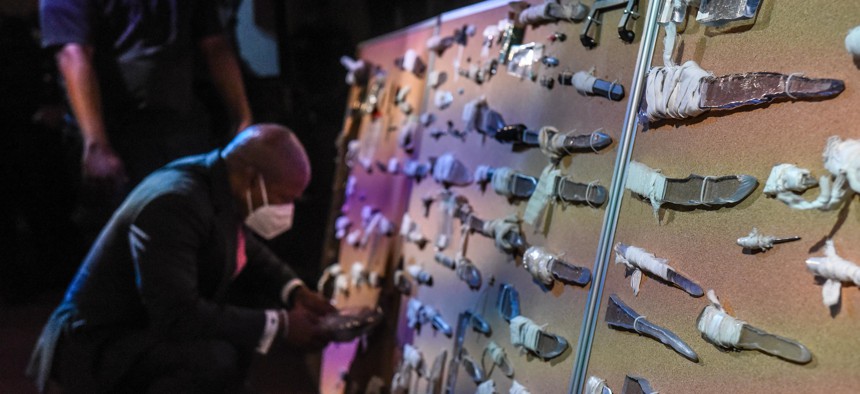Criminal Justice
Eric Adams claims progress at Rikers despite several recent detainee deaths
Attorneys for one of the men who died called the mayor’s announcement “irresponsible and callous.”

Eric Adams with a display of weapons confiscated from those in custody on Rikers Island. Michael Appleton/Mayoral Photography Office
Following the deaths of three men in a single week whose last residence was a New York City Department of Correction facility, Mayor Eric Adams held a press conference Wednesday depicting improvements in conditions at the city’s troubled Rikers Island jail complex. The mayor’s narrative stood in stark contrast to revelations that deaths this year among detainees could outpace the 16 recorded in 2021, the deadliest year since 2013.
After visiting Rikers earlier in the day, the mayor announced that slashings and stabbings at the complex have fallen 63% since March. Assaults on staff and use of force among correction officers have declined 30% and 27%, respectively, compared to the same six months last year, according to City Hall. While standing before a display of weapons confiscated at the jail, Adams also highlighted the seizure of 2,700 weapons and contraband since the end of February, which he attributed to “uniform staff returning to the job and our administration resuming tactical search operations.”
“The era of neglecting the violence and dysfunction of our city’s jails is over,” Adams said in a statement. “Much work remains, but (Department of Correction) Commissioner (Louis) Molina and I are committed to tackling the challenges facing us and implementing the reforms needed to build safer and more humane jails for those who live and work on Rikers.”
Statistics released a week earlier by the Board of Correction showed violence continues to plague the jail complex. At the Eric M. Taylor Center, where one of the detainees who recently died was housed prior to being transferred to a hospital ward, the rate of slashings and stabbings spiked between April and May, as did use-of-force incidents among correction officers, according to Board of Correction data. The board also reported that few newly admitted detainees were electronically screened for contraband in recent months: Of the approximately 1,200 people admitted, only 40 were scanned in May.
Recent Eric M. Taylor Center detainee, Albert Drye, died Tuesday at the Bellevue Hospital Prison Ward, marking the ninth death of someone recently in Department of Correction custody this year. Drye arrived at Rikers in mid-May and was taken to Bellevue around June 1, according to The Legal Aid Society, which represented him. He had been seriously ill prior to his death, The New York Times reported.
The Legal Aid Society said Adams failed to take responsibility for the deaths, calling his public appearance “both irresponsible and callous.”
“This is emblematic of how City Hall views incarcerated people as second-class citizens, guilty until proven innocent and unworthy of compassion,” the organization said in a statement. “The extraordinarily high death rate on Mayor Adams’ watch, and the suffering of all who are kept in abysmal conditions inside, are a humanitarian crisis that this Administration seems incapable of rectifying any time soon.”
A day prior to Drye’s death, Anibal Carrasquillo was found dead at the George R. Vierno Center following an apparent drug overdose, the New York Post reported, citing records and Rikers sources who said fentanyl has been circulating the jail.
And on June 18, Antonio Bradley died three days after the Department of Correction granted him a compassionate release from Lincoln Hospital in the Bronx, the Times reported. Bradley had been at Rikers since October before attempting to hang himself at a Bronx courthouse earlier this month, according to the Times.
The deaths come days after a federal judge said the city could maintain control of Rikers Island. The jail was under threat of a federal takeover following the city’s failure to implement reforms required as part of an ongoing court battle over the inhumane conditions there.
Despite the win in federal court and improvements highlighted by the mayor, the city’s Board of Correction last week raised alarms about continued inhumane conditions at the Eric M. Taylor Center. The facility houses the intake and COVID-19 quarantine units.
A board member who visited the facility earlier this month said “100-plus” detainees were crammed into a single holding pen without access to a bathroom. The board also revealed that three detainees had been sent to the hospital in May alone following assaults in unsupervised areas.
Two of the detainees were attacked by “multiple individuals” in separate incidents on May 13, according to the board’s records. One suffered a laceration to his scalp and a shoulder injury. The other was taken to the Bellevue intensive care unit and underwent “multiple corrective surgeries” on his jaw. The third detainee sustained a concussion and trauma to his liver that resulted in a multiday hospitalization following an attack on May 25.
A total of 113 injuries were recorded at the Eric M. Taylor Center from January through March, the most recent month for which full statistics were available, the board reported.
The Otis Bantum Correctional Center was the only facility to log a higher injury rate. Molina ordered the department on Friday to “immediately” close that facility and transfer staff “to other facilities where they are most needed,” the Post reported, citing an internal memo.
When questioned by the Board of Correction during a hearing last week about the conditions at the Eric M. Taylor Center, Molina cited a staffing shortage, along with a 10-day COVID-19 quarantine policy for new detainees. “As any new guidance emerges from the CDC, we will evaluate the departmentwide operations, including the intake process,” Molina said. The Centers for Disease Control and Prevention, however, only recommends the quarantine for people who have been potentially exposed or come into close contact with someone with COVID-19. It’s unclear if Drye was in the quarantine unit or general housing when he was taken to Bellevue, a Legal Aid Society spokesperson said.

